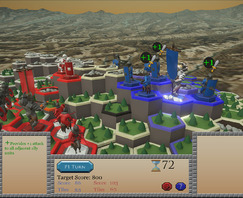
Academics . Game Design . Courses
Game Design Courses
3D Texture, Mapping, Digital Lighting
Course No. ANIM 347 Credits: 3.0
This course is designed to cover concepts in digital application of texture maps for 3D game models rendered in a real-time 3D game engine. Optimization of textures, maps, and materials. Poly count limits, and how to “bake” extremely high levels of detail into low detail models capable of being rendered in real-time, and the benefits of using “Levels of Detail” with static, and dynamic lighting concepts, design, and optimization. The use of toggle-able lighting, and attachment of lighting to game assets and players. The importance of creating immersive environments, capable of being walked through, and/or viewed from multiple, often unspecified angles of view. Projects include concept integration into technical production workflow for describing, and optimizing digital 3D surfaces for rendering in a real-time game engine; creating immersive environments that express mood, and narrative through the materials, and lighting. Projects require the student to continually improve upon conceptual problem solving, time management strategies, communication/presentation and technical skills. 3 credits.
3D Texture, Mapping, Digital Lighting
Course No. GAME 347 Credits: 3.0
This course is designed to cover concepts in digital application of texture maps for 3D game models rendered in a real-time 3D game engine. Optimization of textures, maps, and materials. Poly count limits, and how to “bake” extremely high levels of detail into low detail models capable of being rendered in real-time, and the benefits of using “Levels of Detail” with static, and dynamic lighting concepts, design, and optimization. The use of toggle-able lighting, and attachment of lighting to game assets and players. The importance of creating immersive environments, capable of being walked through, and/or viewed from multiple, often unspecified angles of view. Projects include concept integration into technical production workflow for describing, and optimizing digital 3D surfaces for rendering in a real-time game engine; creating immersive environments that express mood, and narrative through the materials, and lighting. Projects require the student to continually improve upon conceptual problem solving, time management strategies, communication/presentation and technical skills. 3 credits.
Meet Your Faculty view all
Harrison Walsh
Professor of Practice
Harrison has been teaching game design for 13 years at three colleges. During this time, he has also worked on...more
Featured Student Work view all

Our connections are your connections.
While at CIA, you'll learn from the masters through our rigorous, world-class curriculum and connect with working professionals to begin your career.


